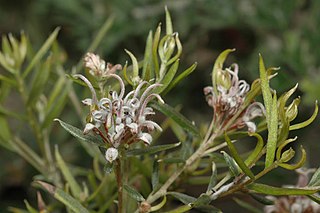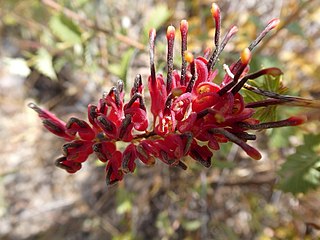
Grevillea buxifolia, commonly known as grey spider flower, is a species of flowering plant in the family Proteaceae, and is endemic to New South Wales, Australia. It is an erect to spreading shrub with elliptic to egg-shaped leaves, and woolly-hairy clusters of rust-coloured to fawn flowers.

Grevillea banksii, commonly known as Banks' grevillea, Byfield waratah, red flowered silky oak and dwarf silky oak, and in Hawaii as kāhili flower, is a species of flowering plant in the family Proteaceae and is endemic to Queensland. It is an erect shrub or slender tree with divided leaves with four to twelve narrow lobes, and creamy white to bright scarlet and yellow flowers.

Grevillea sericea, commonly known as the pink spider flower, is a species of flowering plant in the family Proteaceae and is endemic to New South Wales. It is a shrub with elliptic to lance-shaped leaves with the narrower end towards the base, and clusters of usually pink flowers arranged on one side of a flowering rachis.

Grevillea arenaria, commonly known as sand grevillea or hoary grevillea, is a species of flowering plant in the family Proteaceae and is endemic to New South Wales. It is a spreading shrub with elliptic to egg-shaped leaves with the narrower end towards the base, and red, pink or orange flowers.

Grevillea concinna, commonly known as red combs or elegant grevillea, is a species of flowering plant in the family Proteaceae and is endemic to the south-west of Western Australia. It is a spreading to erect shrub with mostly linear to narrow wedge-shaped leaves sometimes with a sharp point on the tip. Flower colour varies with subspecies.

Grevillea australis, commonly known as alpine grevillea or southern grevillea, is a species of flowering plant in the family Proteaceae and is endemic to south-eastern Australia. It is a spreading to prostrate shrub with simple, narrowly egg-shaped leaves and groups of white to pale pink flowers with a glabrous ovary.

Grevillea dimorpha, commonly known as flame grevillea or olive grevillea, is a species of flowering plant in the family Proteaceae and is endemic to the Grampians National Park in Victoria, Australia. It is an erect to spreading shrub with elliptic to linear or egg-shaped leaves with the narrower end towards the base, and groups of bright red flowers.

Grevillea ilicifolia, commonly known as holly grevillea or holly bush, is a species of flowering plant in the family Proteaceae and is endemic to southern continental Australia. It is a spreading to prostrate shrub with holly-like leaves with sharply-pointed triangular to egg-shaped teeth or lobes, and clusters of green to cream-coloured and mauve flowers with a pink to red style.

Grevillea phylicoides, commonly known as grey spider flower is a species of flowering plant in the family Proteaceae and is endemic to eastern New South Wales. It is a shrub with more or less elliptic to oblong or lance-shaped leaves and woolly-hairy grey flowers.

Grevillea refracta, commonly known as silver-leaf grevillea, is a species of plant in the protea family and is native to northern Australia. It is a tree or shrub usually with pinnatipartite leaves and red and yellow flowers arranged on a branched, downcurved raceme.

Grevillea mimosoides, commonly known as caustic bush, is a species of flowering plant in the family Proteaceae and is endemic to northern Australia. It is a shrub or small tree with curved, narrowly elliptic or egg-shaped leaves and greenish-white to cream-coloured or pale yellow flowers.

Grevillea dryandri is a species of flowering plant in the family Proteaceae and is endemic to northern Australia. It is a spreading to erect shrub with divided leaves with up to seventy or more linear to narrowly elliptic leaves, and long clusters of red, orange-red, pink or white flowers.

Grevillea pauciflora, commonly known as the few-flowered grevillea, or as Port Lincoln grevillea in South Australia, is a species of flowering plant in the family Proteaceae and is endemic to the south of continental Australia. It is an erect to straggly or spreading shrub with linear to narrowly wedge-shaped leaves and red or orange flowers with a red or orange style.

Grevillea quinquenervis, also known as the five-nerved grevillea, is a species of flowering plant in the family Proteaceae and is endemic to the western end of Kangaroo Island in South Australia. It is an erect, dense shrub with more or less linear to oblong or narrowly egg-shaped leaves and clusters of pale to deep pink flowers.

Grevillea trifida is species of flowering plant in the family Proteaceae and is endemic to the southwest of Western Australia. It is a spiny, erect to low spreading shrub, usually with divided, variably-shaped leaves, and clusters of white to cream-coloured flowers.

Grevillea goodii, also known as Good's grevillea, is a species of flowering plant in the family Proteaceae and is endemic to the Northern Territory. It is a prostrate shrub with egg-shaped to narrowly elliptic leaves and clusters of light green flowers with a pink to red style.

Grevillea montana is a species of flowering plant in the family Proteaceae and is endemic to a restricted to a small area of eastern New South Wales. It is a dense shrub with narrowly elliptic to lance-shaped leaves and bright green and pinkish-red flowers.

Grevillea pungens, also known as flame grevillea, is a species of flowering plant in the family Proteaceae and is endemic to the Northern Territory in Australia. It is a shrub with egg-shaped leaves with rigid, sharply-pointed teeth or lobes, and hairy, deep pink to orange flowers.

Grevillea sphacelata, also known as the grey spider flower, is a species of flowering plant in the family Proteaceae and is endemic to the eastern New South Wales. It is a spreading or erect shrub with narrowly linear to oblong leaves and clusters of hairy, pale brown and pink flowers.
Grevillea ceratocarpa is a species of flowering plant in the family Proteaceae and is endemic to inland areas of the south-west of Western Australia. It is an erect or spreading shrub with softly-hairy, narrowly elliptic or narrowly egg-shaped leaves with the narrower end towards the base, and creamy-white flowers.



















